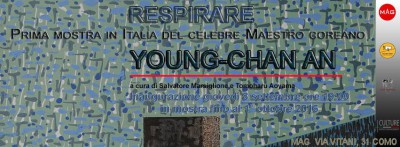“深呼吸” 安 永燦 個展

GALLERY TOMO、MAGギャラリー監修
深呼吸
安 永燦 個展
キュレーション:青山 知相、サルバトーレ・マルシリオーネ
オープニング:9月8日(木) 19:00より
GALLERY TOMO ITALYことMAGギャラリー、ヴィア・ヴィターニ、31、コモにて
会期:2016年9月8日から10月1日迄
※京都のギャラリーは期間中クローズします。
営業時間:火曜日~土曜日
午前10時~13時、15時~19時半迄
ご連絡先:+39 3287521463 info@marsiglioneartsgallery.com www.magcomo.it
後援:ルイージ・ルッソロ資料連盟
展覧会ステートメント
激動の20世紀。グローバリゼーションの時代が高らかに叫ばれてからたくさんの時間が経った。国家、人、それぞれの事実がばらばらになったこの世界で、GALLERY TOMOとMAGによる東洋と西洋を繋ぐプロジェクトで今回焦点を当てるのは、大韓民国のアーティスト、アン・ヨンチャンだ。
アン・ヨンチャンは朝鮮戦争休戦後間もない1959年に韓国は釜山に生まれた。日本の大阪芸術大学に学び、歴史の逡巡を抱える極東の2つの国両方にアイデンティティを得た。1985年に初個展を韓国で行って以降、韓国、日本、アメリカで多数の個展を開催し、そのエネルギッシュな作風は国際的に高い評価を得ている。韓国伝統の韓紙を使った鮮やかな色彩のペインティング、時にはゴムをも使用した支持体を用いるなど誠に融通無碍な作風である。わたしは、作品の支持体とは人々が根を下ろす大地そのもののように感じることがある。西洋におけるカンバス、東洋の韓紙、和紙などそれぞれの大地の上に風土やそこに住まう人々の息遣いも含まれた地域の特色が現れる。
イタリアと韓国は両国ともに半島国家であり、地理的要因から生じる外界からの様々な干渉を受ける運命にあり即ち構成原理が共通する。グローバリゼーションの進展とは、近代まで構築された領域国民国家の在り方を分解されていく過程ともいえる。これは非情な速度で進行しており、そういった現在こそアートというソフトパワーを用いて境界の外の部分、異文化の論理を内在的に理解することが人々の共存のための重要な助けとなる。
私は2年前、ローマのMAXXIでナム・ジュン・パイクの回顧展“THE FUTURE IS NOW!”を観た。彼の制作コンセプトも東洋と西洋の融合がテーマのひとつであったが、異文化と共生するために必要なリテラシーというのは一朝一夕でできるものではもちろんないし、もしかすると共生は言葉自体が欺瞞のようで、不可能なものだとすら思える。しかしながらこの展覧会は、アジア発信の先駆的メディアアートの果たす役割として未来の“定義”を現代に提示していた。我々は当然外交官ではないが、我々の行うアートの果たす役割、文化の交換は各地域文化の歴史的な関係性を理解する上で重要なものだと考えているしわたしたちの展覧会も地域研究の蓄積になるだろう。
アン・ヨンチャンの芸術コンセプトについて大阪芸術大学美術学部教授の坪田政彦はこう言及する。
「アン・ヨンチャンは、自分の呼吸と自分の歩幅で歩くアーティストである。彼は樽の中で、ワインが熟成するように時を待つ。だが決して待つわけではない。血が流れるように脈を打ち、時には、激しく赤・黄・青と鮮やかな色彩に彩られている。火山のマグマのように、豊かな感性と資質が根底に眠り、彼の本質を呼び覚ます。それが彼の仕事を支えている。」
彼のスタイルを感覚的に示す言葉だが、彼は版画家でもなく純粋なペインターでもない。とても自由にふるまう。時代の空気とともに、諧謔性を持って未来に向けて追及していくのだ。これまで描かれてきた作品は木の上に描かれた自画像からシルクスクリーン、犬をモチーフとしたアクリルやオイルなどが代表的なものだ。これらは画材を特定せず無限の宇宙的な拡がりを感じさせる。
しかし、アン・ヨンチャン作品全てに共通する作品の具体的な主題がある。どの作品にも境界線が描かれているのだ。内と外を隔てるこの線は、入口でもあり出口でもある。仏教に衆生(※サンスクリット語でbahujana)という言葉があるがこれは多くの生命が同じ世界に共に生きているという意味だ。絵に込められたこれらの境界線は、自我と他者との関係性を示すものであり、拡張していく世界観と自分を守る領域を様々な動きを見せる異なるドットを描くことによって個性的に表現している。2012年、アメリカはLA アートコアで開催された展覧会はこういったスタンス・作風がアメリカの人々に広範に受け入れられ、快調なセールスを記録した。そしてこの度イタリアデビューとなる本展覧会のために、彼は完全なる新作を準備した。深呼吸をするように新しいページをめくる、アン・ヨンチャンというアーティストの軌跡を可視化する現在進行形のストーリーを皆様のご覧に入れる。
GALLERY TOMO
青山 知相
MAGギャラリー
http://www.marsiglioneartsgallery.com/wordpress/en/young-chan-an-present-breathe-solo-show/

The MAG Gallery and TOMO Gallery of Kyoto
present
Young-chan An, “Respirare”
Exhibition curated by Salvatore Marsiglione and Tomoharu Aoyama
Opening: Thursday September 8th 7.00pm at MAG in Via Vitani, 31 Como.
The exhibition will be on till October 1st 2016
Opening times: fromTuesday to Saturday 10:00am- 1:00pm and 3.00pm- 7.30pm
Info line : +39 3287521463 info@marsiglioneartsgallery.com www.magcomo.it
With the Patronage of the Association Luigi Russolo’s Archives of Como
For the first time in Italy the solo show of the famous Korean artist Young-chan An with a series of 25 absolutely original artworks, especially created for Como’s exhibition.
Statement
Young-chan An, “Respirare”
The 21st century is full of upheaval, and a lot of time has passed since globalization first rang out. In a world where nations and people have become more and more separated, as a project to connect the East and West, GALLERY TOMO and MAG feature the Korean artist, Young-chan An.
Young-chan An was born in Busan in 1959, right after the Korean War cease-fire. Having studied at Osaka University of Arts, he takes his identity from two East Asian countries with indecisive histories. After his first solo exhibition in South Korea in 1985, he has held several solo shows in South Korea, Japan, and the United States, receiving international praise for his energetic style. Indeed, he has a versatile style, with his vividly colored paintings that use traditional kanshi (Korean paper), at times using rubber as a ground. I feel as if these surfaces are like the earth where people lay down their roots. Whether with the Western canvas or East Asian kanshi or washi, among others, artists create topologies on these grounds, and we can see characteristics of each region, including the breath of those people who live there.
Italy and South Korea are both peninsular countries and share a similar fate, having seen interventions from other countries due to their geographical locations. Namely, they share the same fundamental organization. With the development of globalization, we can say the territory of nation-states, constructed until the early 20th century, have been in the process of dismantling. This is continuing at a heartless speed. It is because of this reality that we should use the “soft power” of art to internally understand boundaries and cultural differences, which can be an important factor in helping people to co-exist.
Two years ago, I saw Nam June Paik’s traveling exhibition, “The Future is Now” at MAXXI in Rome. One of his concepts is the fusion of East and West, but there also the idea that the essential literacy needed to harmonize cultural differences cannot be attained in a day; perhaps the word “symbiosis” itself is deceitful and impossible. However, this exhibition, playing a role as cutting-edge media art from east Asia, suggested a “definition” of the future to today. Of course, we are not diplomats, but the role that our art plays and cultural exchange is necessary to understand the historical relationship between regional cultures. No doubt, our exhibition can also add to the accumulation of regional research.
“Young-chan An is an artist who walks by his own breath, at his own pace. He is a wine waiting to mature inside a barrel. But by no means is he just waiting. He is pulsating like flowing blood with intense, brilliant colors — red, yellow, and blue. Like volcanic magma, a rich sensibility and talent lies at his core, evoking his true nature. This is what drives his work.”
This may be an intuitive way of describing his work, but he is neither a printmaker nor pure painter. He is extremely free. Following the spirit of his age, he investigates the future with a sense of jest. Of his works up to now, some of the most representative are his painting of himself painting a self-portrait on top of a tree, his silkscreens, and his acrylic and oil paintings of dogs. Without being limited to a certain material, his oeuvre expands infinitely like space.
There is one concrete motif, however, that runs through all of Young-chan An’s work. In each of his works, boundary lines are painted. These lines that demarcate inner and outer can act as an entrance, but also an exit. In Buddhism, there is the idea of shujo (bahujana in Sanscrit), which means that many living things are co-existing in the same world. The boundary lines in his work represent the relationship between himself and others, and, amongst an expanding world, different dots make shapes and regions with various movements that protect him are uniquely expressed. In 2012, at an exhibition held at Art Core, Los Angeles, this stance and style was widely accepted by Americans, and the show saw excellent sales. For this exhibition, as his debut show in Italy, he has prepared completely new works. A new page has been turned, as if taking a deep breath. Here, we show the visualization of his traces, the present continuous story of Young-chan An, the artist.
GALLERY TOMO
Tomoharu Aoyama
MAG
http://www.marsiglioneartsgallery.com/wordpress/en/young-chan-an-present-breathe-solo-show/
